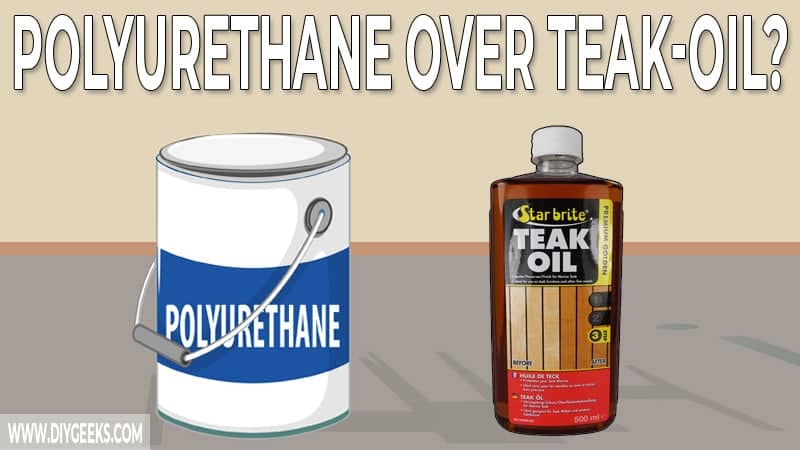Teak oil gives the wood a rich appearance and offers low resistance to water and moisture. You can apply polyurethane over Teak oil to increase the durability of the finish.
Polyurethane doesn’t need to penetrate the surface to stick, so it will stick over it. However, you must sand it before sealing it.
You can’t apply Teak oil over polyurethane because the wood oil needs to penetrate the surface to stick, and polyurethane prevents liquids from penetrating.
Does Polyurethane Adhere Over Teak Oil?
Polyurethane does adhere over Teak oil as it’s a topical sealer and doesn’t need to penetrate a surface to stick.
You must lightly sand the Teak oil finish before applying the sealer to create tiny ridges (or holes) and improve the adhesion.
Use water-based polyurethane as it sticks better without having to penetrate the surface too much.
How Long Must Teak Oil Dry Before Polyurethane?
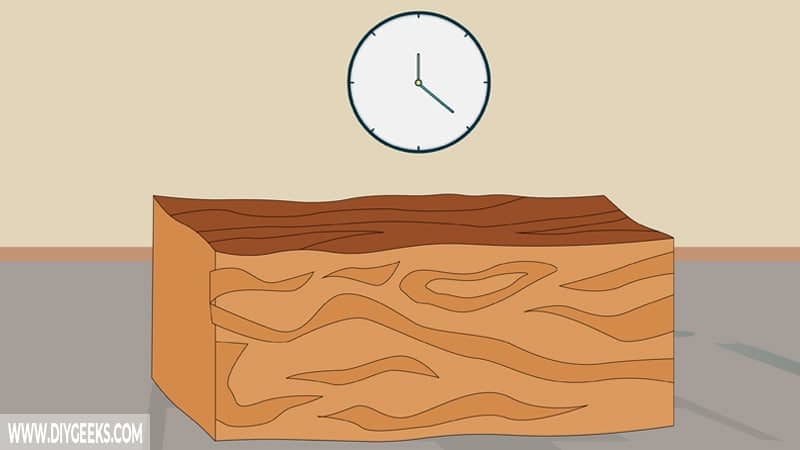
Teak oil must dry (or cure) for 12-24 hours before polyurethane. This gives the wood oil coating enough time to harden and dry enough to support the sealer coating.
For Teak oil to dry and cure, the paint solvent must evaporate and the paint particles must harden — this takes between 12-24 hours.
The exact dry time depends on the humidity levels, number of coats, thickness of the coat, and surface type.
The finish will turn sticky if you seal it too soon as the coating will still be wet (not dry) and the new coating will stop the evaporation process of the existing coating. This will cause the wood oil to bleed through and stain the polyurethane clear coat.
Also, the coating must be rigid because you have to sand it before sealing it. If you sand a wet Teak oil coating, the sandpaper will remove the entire coating and ruin the finish.
How To Apply Polyurethane Over Teak Oil?
To apply polyurethane over Teak oil, do the following.
- Clean and Degrease the Finish.
- Sand the Finish.
- Apply Primer (Optional).
- Apply Polyurethane.
The tools you need for this project are listed below.
- Medium and Fine-grit sandpaper
- Degreaser
- Paintbrush
- Polyurethane
- Clean rags
- Primer
- Paint thinner (optional)
1. Clean and Degrease the Finish
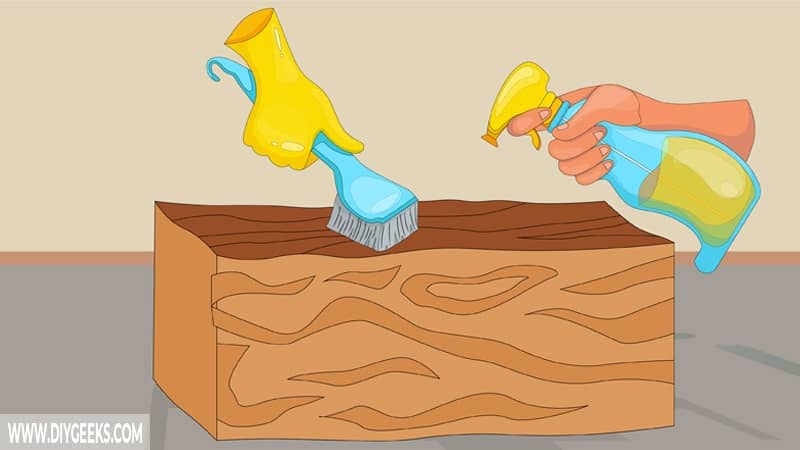
Remove grease, oil, dust, and grime from the finish. If the Teak oil finish has grease or grime, the sandpaper will get clogged with filth.
The clean the finish do the following things.
- Use a cleaning solution or degrease such as WD-40.
- Apply the degreaser.
- Use a soft brush to wipe off the dust and grease from the finish.
- Remove degrease residue using clean water.
- Leave the finish to dry.
2. Sand the Finish

Sand the finish with fine-grit sandpaper to remove bumps and imperfections so the sealer can stick and dry properly. Remove the dust from the finish with a clean rag (or vacuum) after sanding.
Use medium-grit sandpaper (100-grit) or a paint-stripping compound if you want to remove the Teak oil completely from the surface.
3. Apply Primer (Optional)
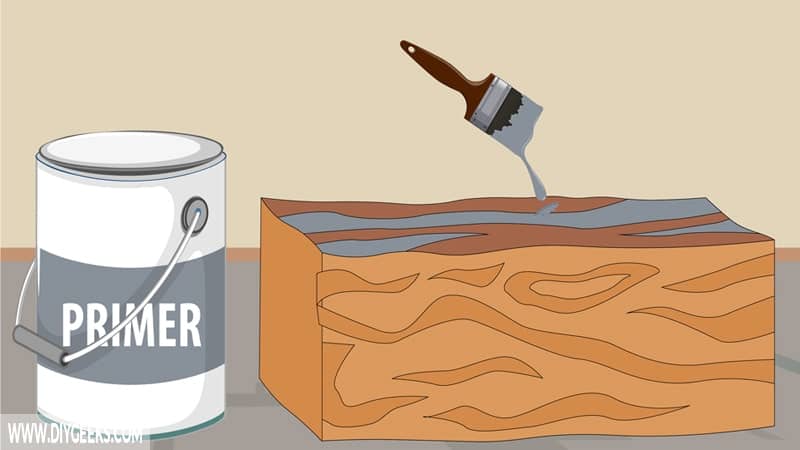
Use paint primer if you want to cover the color of the Teak oil and improve the adhesion. Polyurethane is a clear coat (colorless), so the color shade of the finish won’t be changed if you apply it.
So, if you want to change the color of the finish, apply a coat of paint primer. The primer will help the sealer to stick better over oiled surfaces, too.
We recommend using latex or acrylic paint primer.
Note: This step is optional, so you can skip it.
4. Apply Polyurethane
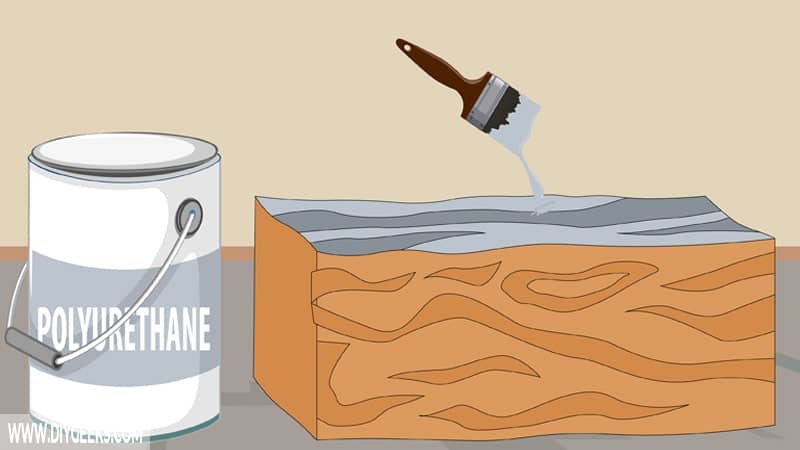
You can spray or brush the polyurethane over Teak oil. To spray polyurethane, use a sprayer, and to brush it, use a bristled paintbrush or a paint roller.
You must thin oil-based polyurethane with mineral spirits before applying it. This makes its coating lighter, easier to control and helps it to dry faster.
You must apply 2-3 coats of polyurethane. Wait until the previous coat dries before applying the next one.
Can You Mix Teak Oil With Polyurethane?
You can mix oil-based polyurethane with Teak oil because both finishes use oil as their solvent and are compatible with each other.
Oil-based polyurethane is thicker than Teak oil. So, use it less in the mixture or thin it with turpentine to make its flow light and smooth.
If you mix Teak oil with water-based polyurethane, the mixture will vary in color, dry time, solvent, and consistency. That’s because water-based polyurethane uses water as its paint solvent, and water isn’t compatible with oils.
Also, they have different dry times. So, if you mix them, one part of the mixture will dry while the other will still be wet. This will cause the paint (mixture) to crack and peel off.
Can You Apply Teak Oil Over Polyurethane?
You can’t apply Teak oil over polyurethane because it can’t penetrate the coating and won’t stick.
Polyurethane forms a glossy moisture-resistant layer over the surface that prevents liquid from penetrating it.
To apply Teak oil over polyurethane, you must sand the sealer finish or remove it completely. Sanding the stress areas of the sealer will create holes (or spaces) for the wood oil to penetrate and stick to. But, the bonding won’t be as good. .
